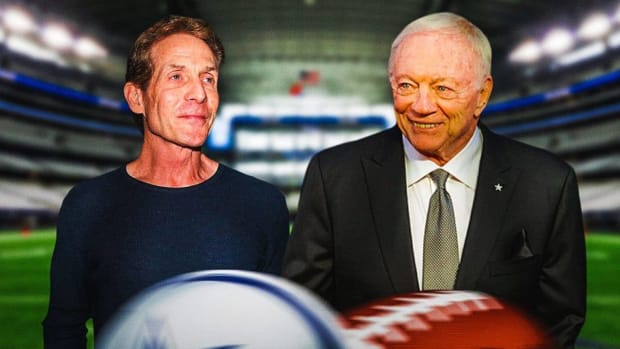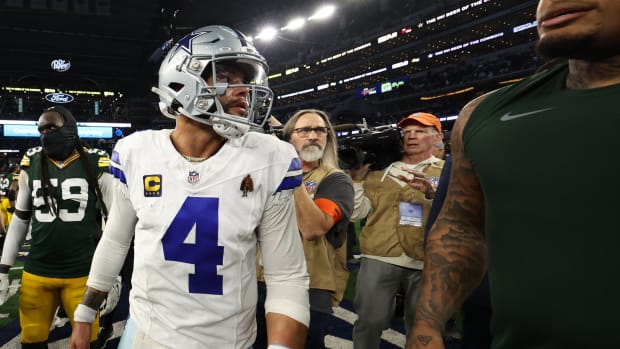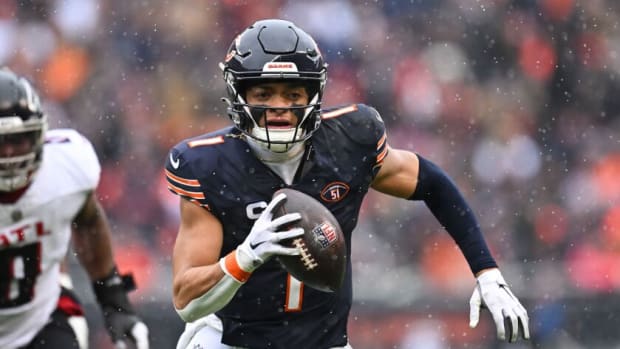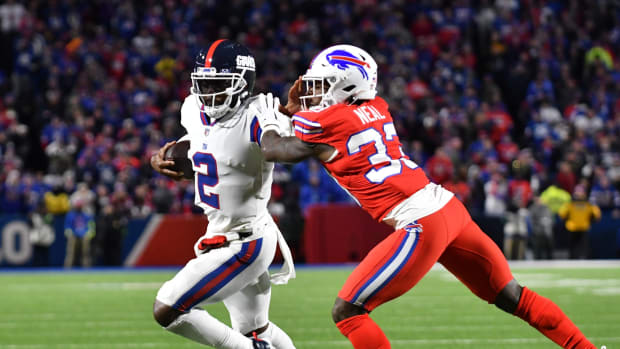SI 50, Nos. 22–21: William Jackson III and Su’a Cravens
With the 2016 NFL draft only a month away, it’s time for all 32 NFL teams to finish the process of getting their draft boards in order and ranking players based on their own preferences. At SI, it’s time for us to do that as well. To that end, Doug Farrar has assembled his own Big Board, with his top 50 players.
The SI 50 uses tape study to define the best prospects in this class, and why they're slotted as such. As we continue with the first round of players, it's time to take a closer look at a potential number-one NFL corner, and the man who may be the most versatile player in this entire draft class.
• FARRAR: Counting down SI’s top 50 prospects of 2016 NFL draft
22. William Jackson III, CB, Houston
Height: 6' 0" Weight: 189
Bio: Jackson has become one of the most heralded pass defenders in this draft class, but he certainly didn’t start out that way. After transferring from Trinity Valley Community College, he became a fixture in Houston’s defense in 2014 and was named a second-team American Athletic Conference pick with 22 solo tackles, two interceptions and 10 pass deflections. But it was last season’s numbers that really put him on the national stage: 34 solo tackles, five interceptions (two returned for touchdowns), and 23 pass deflections to lead the nation in that category. Then, he blew up the scouting combine with a 4.32 40-yard dash, a 1.52 10-yard split, and a 9' 8" broad jump, ranking near the top among cornerbacks in all three drills. His combination of athletic ability and promising tape means that Jackson could easily find himself as a first-round pick.
NFL draft Big Board: 2016’s top 100 prospects
Strengths: Has allowed 40% of his passes thrown to him to be completed over the last two seasons. Good-sized cornerback who plays bigger—Jackson brings an aggressive mentality to press coverage. Has the agility to turn the corner, pinning outside receivers to the boundary with inside position. Has the coverage chops to seamlessly send his aligning receiver into zone coverage while tightly covering his assigned receiver. Closes quickly with excellent recovery speed on targets running routes with quick back-end angles like curls and comebacks. Has an even stride to the seam on deeper routes. Mirrors to the corners of routes very well; has the consistent ability to track receivers at all levels. Shows a consistent ability to play bail and off coverage, closing in zone spaces. Attacks the ball with good timing and aggression—a primary reason for his high interception and deflection totals. Keeps his eye in the air on deep timing passes and has the mentality that the ball belongs to him. Good vertical and long arms give him an impressive catch radius. Good wrap tackler when he isn’t going for the kill shot. Showed good improvement in footwork and spatial awareness from year to year.
Weaknesses: Back-end speed is questionable, as he’s not a center fielder and can be outrun deep. Jackson could stand to be more efficient with his feet and overall positioning, and he can get turned around by quicker slot receivers and put out of place in open spaces. Needs to be less high in his stance at times to avoid losing ground against faster receivers running more complex route concepts. Less flexible in his hips than is expected from a top-level cornerback, he tends to flip to cover with athleticism instead. Could find himself out-muscled by bigger receivers when pressing at the NFL level. Not a blitzer or a run support asset at a high enough level. Needs to be more aware of screens and short passes. Can get too handsy at times, leading to penalties. Needs to be an outside corner at this point, since he isn’t tight enough in the slot to break into the lineup that way.
Conclusion: Teams have learned to covet the big cornerback who plays even bigger, and Jackson has proven that he’s this style of player. If he can be more efficient in his body movements, he has the potential to be a No. 1 starter in the NFL. Certainly, he has what it takes to be a second-tier outside cornerback who will get a ton of reps and make some big plays. Jackson’s star is on the rise.
Pro Comparison: Kareem Jackson, Texans (first round, 2010, Alabama)
21. Su’a Cravens, LB/S, USC
Height: 6' 1" Weight: 226
Bio: Cravens is a cousin of Dolphins tight end Jordan Cameron, a distant cousin of Chargers linebacker Manti Te’o, and his mother’s second cousin is former Bengals safety David Fulcher, who was one of the first players to benefit from Dick LeBeau’s zone blitz concepts in the early 1980s. After being named the USA Today National High School Defensive Player of the Year in 2012, Cravens made an immediate impact with the Trojans, posting 39 solo tackles, 2.5 tackles for loss and four interceptions as a true freshman in ’13. Over the next two seasons, he was transformed into more of a line of scrimmage and linebacker-depth player, amassing 95 solo tackles, 32 tackles for loss, 10.5 sacks, five interceptions, 15 passes defensed and two forced fumbles over those two seasons.
The Case For ... taking a chance on Okla. State CB Kevin Peterson
The stats reflect Cravens’s versatility, and he’s ready to prove that to whichever team drafts him.
“I just think I bring versatility to the next level,” he said at the combine. “I know the role of being a big safety is beginning to change. I think before it was kind of frowned upon. But now that guy that can run with slots and guard tight ends in man and then come into the box and be that extra linebacker without having to sub, it’s pretty big nowadays. With the league becoming a passing league you’re going to need guys like that, so I think now, I’m at an advantage more than a disadvantage.”
Cravens is exactly right. He’ll definitely be on the field in 2016. The only question is where.
Strengths: Multi-positional star who plays well everywhere, from the strong safety position to the slot to weakside linebacker depth to up near the line as a run-stopper and blitzer. Shows the recognition and backpedal speed to shift from run support to curl-flat defense in a split second. Has the play strength to at least tussle with offensive linemen 80 pounds heavier than he is. Practiced at beating open-field blocks and getting to the ballcarrier. Extends his arms quickly to at least stay in the play, even when he’s overwhelmed by size. Will take tight ends all the way up the seam and has the flexibility to stay with them through the route. Flies into the backfield on unopposed blitzes and ends plays quickly once he gets there, if he’s using correct tackling form. When he has his feet facing the target and he’s ready to explode to the ballcarrier, Cravens is capable of mirroring very well in the open field. Has the sideline-to-sideline speed to take care of outside running backs and receivers on quick routes. When he’s on, Cravens lives in the backfield and has a knack for creating losses and stuffs. Has a fiery temperament and loves to mix it up, regardless of where he’s playing.
Weaknesses: Can be gangly and reckless in the open field; he will miss tackles on whiffs because he plays too fast and without optimal control. Needs better backfield recognition, as he can be fooled on play-action concepts, stretch handoffs and reverses. More of a drive-by tackler and a kill-shot artist than a consistent wrap tackler on a play-to-play basis. Dives and misses far too often; his tackle numbers could be ridiculous if he curbs that. Sneakier receivers could drive him nuts at the NFL level because he is so insistent on playing with his hair on fire. Struggles at times to re-direct if the play doesn’t go the way he expects. Can get caught staring into the backfield in bail coverage.
Conclusion: The NFL has changed a lot in the last decade. Safety-linebacker hybrids like Michael Boulware used to come into the NFL without a defined position and tended to fade away quickly. But in today’s multiple pass defenses, where nickel and dime coverage have become the dominant base concepts, “tweeners” are more valuable than they’ve ever been. Many see Cravens as a traditional weakside linebacker, but I see him as a more valuable piece in the mold of what the Cardinals were smart enough to do with Deone Bucannon.
Arizona took Bucannon with the 27th pick in the 2014 draft and played him as a primary strong safety in his rookie season. Then, after losing Daryl Washington to suspension and Karlos Dansby to free agency and failing to fill those holes, they put Bucannon in a “Moneybacker” or “$LB” role, where he roamed from middle depth and made all kinds of non-traditional plays. The team that takes its nickel package and adjusts it to personnel, as the Cardinals did with Bucannon, may be the team that can get the most out of Cravens as a range player with rare positional depth.
Pro Comparison: Deone Bucannon, Cardinals (first round, 2014, Washington State)




































